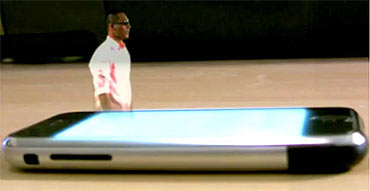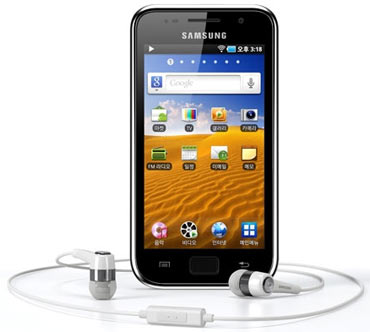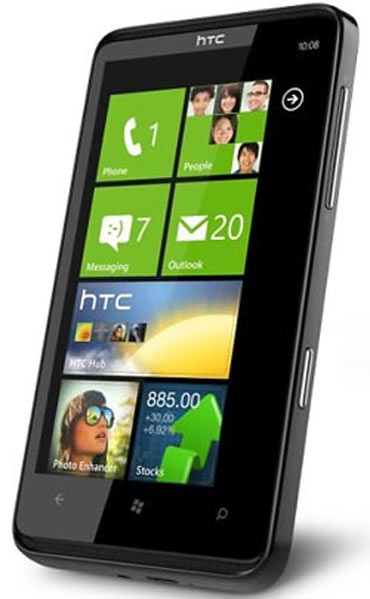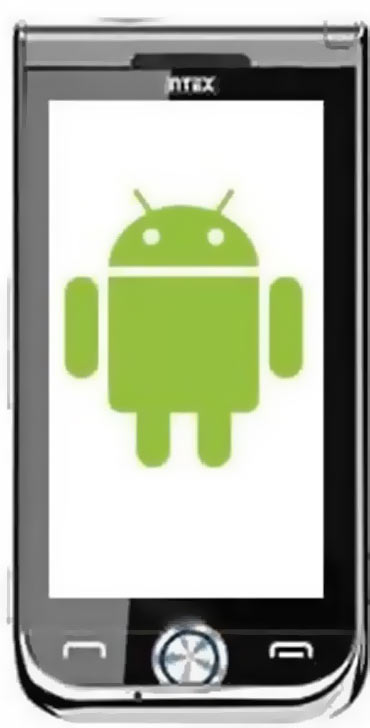Abhinav Lal and Vinod Yalburgi, ThinkDigit.com
A quick roundup of smartphones that were released in 2010, smartphones that are due for launch in the New Year and pathbreaking technologies that promise to produce clean energy inexpensively and transfer high-speed data on photon networks instead of fibre optics.
HTC to launch HTC Mozart and Desire HD in India soon
It is great news for all the HTC fans and high-end smartphone users alike, as HTC has apparently announced the launch of HTC Mozart and HTC Desire HD in India. The HTC Mozart will run on the Windows Phone 7 platform, while the HTC Desire HD will run on Android 2.2 (Froyo) platform with HTC Sense UI.
The HTC Mozart is estimated to be priced around Rs 30,000 at the time of its launch in India. The first WP7 device to be found at Indian e-tailers was also an HTC device, the HTC HD7 that was launched a couple of days ago (more about it in slide 5).
The Mozart includes the following specifications: 3.7-inch Super LCD touch-screen display, Qualcomm Snapdragon QSD 8250 1 GHz processor, 8 megapixel camera with Xenon Flash, SRS and Dolby Mobile Sound Enhancement, 8GB internal memory, 512MB ROM, 576MB RAM, Bluetooth 2.1+EDR, up to 720p HD video recording. In addition, it includes ambient light sensor, digital compass and proximity sensor.
Supporting a 4.3-inch S-LCD touch-screen display with a screen resolution of 480x800, the Desire HD is said to be the big brother of HTC Desire and a distant cousin of HTC EVO 4G. Incorporating a performance hungry hardware configuration, the Desire HD includes 1GHz Snapdragon processor with 1.5 GB internal memory and 768MB RAM.
The feature-rich hardware is optimised with HTC Fast Boot feature, to improve boot times, reduce resource overheads and enhance the overall system performance.
In addition, the Desire HD includes an 8 megapixel camera with dual-LED flash & geo-tagging. The camera also supports face tagging and 720p HD video recording.
The multimedia support includes: DivX & Xvid video formats, Dolby Mobile and SRS surround sound formats.
The Desire HD is reportedly available for pre-order at a special discounted price of Rs 27,499 from FlipKart's online retail store. However, the official price is said to be Rs 30,319.
A quick roundup of smartphones that were released in 2010, smartphones that are due for launch in the New Year and pathbreaking technologies that promise to produce clean energy inexpensively and transfer high-speed data on photon networks instead of fibre optics.
Apple developing glasses-free 3D and holographic display technology
Image: Apple 3D displayA patent filed in 2006 shows Apple's interest in the 3D realms, showing a new type of three dimensional and holographic glasses-free display. A lot has changed since 2006 since, and while the patent probably had concentrated on television, monitors and even projection systems, its present applications in smaller, mobile segment are certainly appealing to Apple, the company behind the bestselling iPhone and iPad devices.
The display technology supposedly uses lens-like bumps on the screen that deflect stereoscopic images from each pixel into the right and left eyes of the viewer.
While it does seem like the viewing angles would be quite limited with this approach, and not ideal for multiple viewers, Apple's patent claims the display combined with 3D imaging technology would be able to track the movements of multiple viewers and manipulate the deflected image to keep it crispy and auto-stereoscopic for all.
The combination apparently will also allow for holographic images to projected, or at least 'pseudo-holographic' images.
By tracking movements of the eye locations of the observer, the left and right 3D sub-images are adjusted in response to the tracked eye movements to produce images that mimic a real hologram. The invention can accordingly continuously project a 3D image to the observer that recreates the actual viewing experience that the observer would have when moving in space around and in the vicinity of various virtual objects displayed therein. This is the same experiential viewing effect that is afforded by a hologram.
It allows the observer, for example, to move around a virtual object and top observe multiple sides from different angles.
While Apple is an unlikely company to beat out the display giants in the business, if it perfects the glasses-free 3D technology -- and as an added bonus: holographic images -- it might just have a jumpstart in the industry, especially the content providers.
Check out: The all new Gadgets and Gaming page
Reader invite
Are you a gadget/gaming wizard/afficianado? Would you like to write on gadgets, gaming, the Internet, software technologies, OSs and the works for us? Send us a sample of your writing to gadgetsandgaming@rediffmail.com with the subject as 'I'm a tech wizard/afficianado' and we will get in touch with you.
Samsung to show off Galaxy Player -- a Galaxy S derived Froyo-based PMP -- at CES 2011
Image: Samsung Galaxy PlayerSeems like Samsung is following in Apple's footsteps once again, and plans to release a portable media player that is just as subtly emasculated as the iPod Touch is with respect to the iPhone 4. It will supposedly be shown off by the Korean giant at the upcoming CES 2011 show, where Motorola will show off its Android Honeycomb tablet.
Known as the Samsung Galaxy Player, the device will be physically and internally similar to the Samsung Galaxy S, apparently retaining the same 9.9mm thickness while doing away with 2G and 3G connectivity, and the high resolution rear camera.
While this makes it a fair bit thicker than the razor slim 7.2mm iPod Touch, it certainly isn't going to be uncomfortable to hold or carry around. As for other features, the device will sport a fully-funcitonal Android 2.2 Froyo operating system, Wi-Fi, and Bluetooth 3.0. making the player just as multi-faceted (and without the dependence of iTunes, maybe a little more) a device as the iPod Touch, doing everything from e-mail to gaming to productivity.
The device will have access to both the Android Market and the Samsung Apps stores and will also have a GPS sensor on board, something the iPod Touch doesn't have.
The Galaxy Player will feature a 4-inch SuperLCD screen (800x480) instead of the Galaxy S's Super AMOLED screen, but then again, that's expected, with Samsung pushing the former technology as the future of displays. It will sport a 3.2MP camera at the rear, with a front-facing camera for video calls.
Check out: The all new Gadgets and Gaming page
Reader invite
Are you a gadget/gaming wizard/afficianado? Would you like to write on gadgets, gaming, the Internet, software technologies, OSs and the works for us? Send us a sample of your writing to gadgetsandgaming@rediffmail.com with the subject as 'I'm a tech wizard/afficianado' and we will get in touch with you.
CalTech researchers use sunlight to make liquid hydrocarbon fuels inexpensively
Image: Cheap hydrocarbon fuels from sunlightScientists at CalTech have designed a reactor that uses sunlight to create liquid hydrogen fuel. The prototype is already small enough to be used in domestic areas, and in its present iteration, produces an average of 11.4 litres of fuel each day.
The reactor uses an abundant mineral, cerium oxide, as the primary catalyst, which is another point for its favourable reception. It works by directing sunlight using a parabolic mirror into the reaction chamber to heat up the cerium oxide catalyst, which in turn releases oxygen atoms from its crystal lattice molecular structure.
When cooled back down, the cerium oxide pulls oxygen atoms from the surrounding chemicals (in this case, water and carbon dioxide) in the reactor, producing hydrogen and carbon monoxide, a gaseous mixture that can be used to create a variety of hydrocarbon fuels (as we saw in other recent renewable energy proposals, where carbon dioxide and water were once again used to make hydrocarbon fuels).
California Institute of Technology's Professor Sossina Hail, one of the lead researchers on the project, commented on the importance of the cerium based catalyst, which is found in relative abundance, especially compared to convential rare catalysts elements such as platinum and vanadium: "The trick here is the cerium oxide, it is very refractory, it's a rock... But it still has this incredible ability to release oxygen. It can lose one in eight of its oxygen molecules there is plenty of cerium for this technology to make a major contribution to global gasoline supplies."
From what we've read on the technology, this technique doesn't strictly require pure/freshwater to work, as cerium oxide will liberate oxygen regardless (notwithstanding of course, some reactions with the impurities). If true, this could mean seawater, the most abundant source of water in the world, can also be used to create liquid hydrogen or hydrocarbon fuel -- a utopian dream come true.
Check out: The all new Gadgets and Gaming page
Reader invite
Are you a gadget/gaming wizard/afficianado? Would you like to write on gadgets, gaming, the Internet, software technologies, OSs and the works for us? Send us a sample of your writing to gadgetsandgaming@rediffmail.com with the subject as 'I'm a tech wizard/afficianado' and we will get in touch with you.
HTC launches India's first Windows Phone 7 device HTC HD7
Image: HTC HD7India's first Windows Phone 7 device is officially here -- the HTC HD7. With a MOP of Rs 29,990, the HTC HD7 is the spiritual successor to the massive HTC HD2, bearing the same sized 4.3-inch 480x800 resolution screen, however, with normal LCD instead of the Super AMOLED of its predecessor.
As you'd expect, it has a 1GHz processor, 720p HD video recording, and a fair bit more RAM than the HD2, as well as 8GB internal storage.
In place of the famous HTC Sense UI, HTC has developed the HTC Hub interface and native application that works with the WP7 Hub and Tile experience, offering users easy access to their latest and valuable information neatly divided into People, Pictures, Games, Music & Video and Office content.
Check out: The all new Gadgets and Gaming page
Reader invite
Are you a gadget/gaming wizard/afficianado? Would you like to write on gadgets, gaming, the Internet, software technologies, OSs and the works for us? Send us a sample of your writing to gadgetsandgaming@rediffmail.com with the subject as 'I'm a tech wizard/afficianado' and we will get in touch with you.
Intex to launch India's cheapest Android phone in February 2011, for Rs 5,500
Image: Intex AndroidIntex has reportedly announced the release of its cheapest Android smartphone in the first week of February 2011, priced at just Rs 5,500. Just as we were wondering about its unexpected entry into the mobile market a few months back, it appears that Intex is determined to establish its market share in the lucrative Android cellphone market.
It is expected to directly compete against the likes of Micromax's Andro A60, vying for the title of "cheapest Android cellphone" in the Indian market, as well as the upcoming Froyo-based Huawei U8140.
The Intex smartphone will reportedly ship with Android 2.2 (Froyo), 3.2 megapixel camera, 2.8-inch resistive touchscreen, Wi-Fi and GPS.
This should be great news for all the Android fans who have expecting something more affordable!
Check out: The all new Gadgets and Gaming page
Reader invite
Are you a gadget/gaming wizard/afficianado? Would you like to write on gadgets, gaming, the Internet, software technologies, OSs and the works for us? Send us a sample of your writing to gadgetsandgaming@rediffmail.com with the subject as 'I'm a tech wizard/afficianado' and we will get in touch with you.
Nikon patents versatile manual and electronic zoom lens for DSLR video recording
Image: Nikon's Zoom technologyIt seems that Nikon is working proactively to aid those individuals who like to shoot video with their DSLR cameras. While most DSLR cameras can shoot videos of 720p HD quality or better, a major difference between these cameras and professional (and prosumer) video cameras is that the user of a DSLR has to adjust the lens focus manually while manually zooming, a task that requires unnecessary dexterity and effort, and usually results in some rather blurry and shaky transitions.
To make such issues obsolete, Nikon has filed a patent for a lens that can be zoomed both manually and electronically, and will presumably be controlled by a zoom rocker on the camera body.
So while purists would not be happy with a motorised/electronic zoom, they would also not be using a DSLR to shoot videos.
The rest of the DSLR world however, would welcome Nikon's latest innovation, and we look forward to the technology making its way soon into markets. While Canon fans and common sense advocates will claim this is no mean feat of engineering (and we agree), we're still happy Nikon is acknowledging the problem and providing a solution.
Check out: The all new Gadgets and Gaming page
Reader invite
Are you a gadget/gaming wizard/afficianado? Would you like to write on gadgets, gaming, the Internet, software technologies, OSs and the works for us? Send us a sample of your writing to gadgetsandgaming@rediffmail.com with the subject as 'I'm a tech wizard/afficianado' and we will get in touch with you.
DARPA and Raytheon developing free-space photon networks to replace fibre optics
Image: Photon networkSo far, optical fibres are the pinnacle of data transfer performance across large distances, but DARPA is not satisfied being dependent on wired technology, and has commissioned Raytheon BBN Technologies to develop a new photon-based optical network.
Part of DARPA's Information in a Photon programme -- which is focussed on both communication and imaging -- the new system promises to be able to deliver very large amounts of data much faster than today's optical networks, and in fact, can even send data between Earth and space.
Scientists at Raytheon BBN Technologies are hoping to be able to use free-space optical (FSO) communication to its maximum potential. FSO are types of lasers that can transmit and receive data between two points, without them being connected physically by fibre optic cables.
The technology, quite futuristic, has quite a few hurdles it needs to cross before it becomes mainstream, such as strength, range and decay of laser signals, climate and radiation interference, and more.
Raytheon is working to create photon networks that will replace today's optical communications technologies.
Check out: The all new Gadgets and Gaming page
Reader invite
Are you a gadget/gaming wizard/afficianado? Would you like to write on gadgets, gaming, the Internet, software technologies, OSs and the works for us? Send us a sample of your writing to gadgetsandgaming@rediffmail.com with the subject as 'I'm a tech wizard/afficianado' and we will get in touch with you.
Micromax and modu tie-up: Present the world's lightest 3.5G touch phone in India
Image: Micromax modu TMicromax holds the record for being the largest Indian domestic handset company, in terms of the units shipped during the quarter ended March 31, 2010 and the third largest mobile handset seller as on March 31, 2010. Adding one more feather to its cap of remarkable achievements, Micromax has announced the release of modu T -- the world's lightest 3.5G touchphone -- in India.
The modu T holds a Guinness World Record, with a feather-weight of 55 grams excluding the accessories or attachments. This product is a result of the joint association between Micromax, modu, Qualcomm and Aircel (official service carrier).
You would be surprised to know what the modu T has in store for the common man and the tech-savvy gadget geeks alike.
It brings compactness and portability with the assurance of affordability at a tempting price of Rs 12,500.
The display is just 2.2-inches in size and the whole mobile accounts to a matchbox size sans the modu attachments. The innovative assortment of modu attachments include: camerafy, sportfy and textfy.
The "fy" terminology signifies the enhancement features that can redefine the smartness of the modu T smartphone in different ways. You could reportedly slide in the modu T phone into the compact and intuitive 5MP camerafy and start capturing or sharing the most cherished moments of your life.
Sportfy is meant to serve you as the exercise companion, providing stats on your training schedule, workouts, route tracker and performance online.
Finally, the textfy adds the QWERTY keypad modification to your modu T touch phone, giving you the freedom of ergonomic typing and comfortable usage, particularly if you are computer geek!
Adding the icing on the cake, Micromax in association with Aircel promises you 3 months of free 3.5G data service, that could serve your evaluation needs.
The phone reportedly ships with feature-rich funtionalities including web access, instant messaging, direct links to different social networks, as well as a built in FM radio, GPS, and music player. modu T is also said to include a wide variety of applications such as: YouTube, Google Search, Twitter, Facebook, Flickr, TuneWiki, eBuddy, Snaptu and operate on Qualcomm's Brew operating system.
With all due credit, the modu T promises to revolutionize the 3G touch phones in India, with a hint of lifestyle accessories and ultra-portable form-factor.
Check out: The all new Gadgets and Gaming page
Reader invite
Are you a gadget/gaming wizard/afficianado? Would you like to write on gadgets, gaming, the Internet, software technologies, OSs and the works for us? Send us a sample of your writing to gadgetsandgaming@rediffmail.com with the subject as 'I'm a tech wizard/afficianado' and we will get in touch with you.











Comment
article